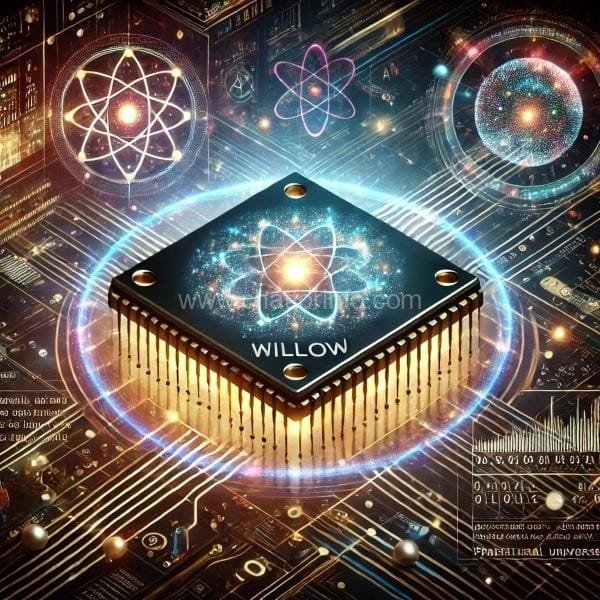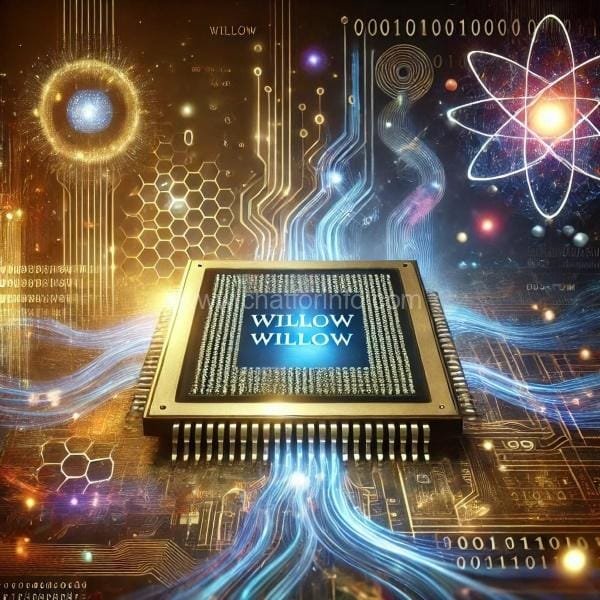The world of technology is abuzz with Google’s latest breakthrough: Google Willow Quantum Chip. Announced recently, this innovation has sparked significant interest across industries, with even Elon Musk tweeting, fueling discussions about the implications of this technological leap. Let’s dive into the fascinating aspects of this new quantum technology, its potential benefits, and the challenges it may pose. Google CEO Sundar Pichai wrote “Introducing Willow, our new state-of-the-art quantum computing chip with a breakthrough that can reduce errors exponentially as we scale up using more qubits, cracking a 30-year challenge in the field,” Expressing admiration for Willow, the Tesla CEO Elon Musk’s Tweet simply dropped a one-word reaction in the comment section- “Wow”!! Musk’s ventures like Tesla and SpaceX could greatly benefit from advancements in quantum computing, especially in battery optimization and space exploration.

What is the Willow Quantum Chip?
The Willow Quantum Chip is a next-generation quantum computing processor developed by Google. Boasting 105 qubits, it leverages advanced quantum mechanics principles such as superposition and entanglement to perform calculations that are impossible for traditional computers.
Key highlights include:
- 7×7 Qubit Grid Design: Willow can operate efficiently with error correction, reducing 3 errors at a time, effectively leaving 97 usable qubits for complex computations.
- Quantum Error Correction: A revolutionary feature ensuring stability and accuracy in computations, addressing a critical hurdle in quantum computing.
- Coherence Improvements: Willow’s advanced materials and design enhance coherence time, allowing quantum states to persist longer, improving reliability.
Willow’s Performance: A Multiversal Feat
Willow’s performance on certain benchmarks is nothing short of astonishing. It completed a computation in under five minutes that would take one of today’s fastest supercomputers 1025 years—or 10 septillion years. Written out, that’s 10,000,000,000,000,000,000,000,000 years, a figure that vastly exceeds the age of the universe and known timescales in physics.
This achievement lends credence to the theory that quantum computation occurs in many parallel universes, aligning with David Deutsch’s multiverse hypothesis, which suggests that quantum phenomena operate across multiple realities simultaneously.
Principles Behind Quantum Computing
Qubits: The building blocks of quantum computers. Unlike classical bits, which represent 0 or 1, qubits can exist in multiple states simultaneously (superposition).
Superposition: Allows qubits to perform many calculations at once.
Entanglement: Qubits can be interlinked, such that the state of one affects the other, enabling ultra-fast data processing.
Electrons and Photons: Willow leverages electron and photon interactions for precision and energy efficiency.
Is Willow’s Threat to Cryptography and Blockchain?
One major concern surrounding Willow is its potential to disrupt cryptography, the backbone of digital security systems. Classical encryption methods, such as RSA, depend on the difficulty of factoring large numbers—a challenge quantum computers like Willow could solve in seconds.
This development could also pose risks to blockchain technology, as quantum processors may theoretically break the cryptographic protections of cryptocurrencies like Bitcoin. While solutions like quantum-resistant cryptography are in the works, the arrival of powerful chips like Willow brings the urgency of adaptation to the forefront.
Benefits of the Willow Quantum Chip
Medical Advancements:
- Simulating complex molecules to accelerate drug discovery.
- Revolutionizing personalized medicine with precise diagnostics and treatment plans.
Battery Innovations:
- Improving Li-ion battery performance for electric vehicles and renewable energy storage.
AI Enhancements:
- Quantum computing could supercharge AI algorithms, enabling faster learning and improved decision-making.
Climate Solutions:
- Modeling climate systems and optimizing renewable energy grids for better sustainability.
Everyday Applications:
- Quantum-powered data encryption, logistics optimization, and even personalized finance tools could make life more secure and efficient.

Google vs. Classical Supercomputers
Unlike traditional supercomputers that rely on brute force to solve problems, quantum computers like Willow solve problems by exploring quantum probabilities. This paradigm shift can exponentially reduce the time required for computations, giving Willow an edge in fields like material science, financial modeling, and global logistics..
Challenges and Limitations
Cost and Scalability: Quantum computing hardware remains expensive and challenging to scale for widespread use.
Quantum Error Rates: Although Willow addresses some error correction issues, achieving fault-tolerant quantum computing is still a work in progress.
Ethical Concerns: The potential misuse of quantum computing for breaking encryption or surveillance raises questions about responsible use.
Willow and the Future of Quantum Technology
Willow’s unveiling marks a significant step forward in the race for quantum supremacy, positioning Google at the forefront of innovation. The 105-qubit chip opens new possibilities in science, medicine, and industry, promising to revolutionize how we solve complex problems.
For normal people, this means faster internet, more secure online transactions, better healthcare, and sustainable energy solutions. For the scientific community, Willow represents the dawn of a new era in computational power.
Conclusion
The Google Willow Quantum Chip is not just another innovation; it’s a glimpse into the future of technology. While its potential benefits are groundbreaking, the challenges it poses—especially to security systems like cryptography—cannot be ignored. As we embrace this quantum leap, collaboration among governments, tech companies, and researchers will be crucial to harnessing its power responsibly. Join our Future Tech Forum to discuss more.
Disclaimer
This blog is for informational purposes only. Quantum computing technology is complex, and its impact on various industries is speculative. Readers are advised to consult experts or official sources for accurate information.
Excellent way of explaining, and pleasant piece of writing to take
information concerning my presenbtation subject, which i aam going to deliver in university. http://Boyarka-Inform.com/
Howdy just wanted to give you a quick heads up and
let you know a few of the images aren’t loading properly.
I’m not sure why but I think its a linking issue.
I’ve tried it in two different web browsers and both show
the samee outcome. http://boyarka-inform.com/
Good – I should certainly pronounce, impressed with your website. I had no trouble navigating through all the tabs as well as related information ended up being truly easy to do to access. I recently found what I hoped for before you know it in the least. Quite unusual. Is likely to appreciate it for those who add forums or anything, site theme . a tones way for your customer to communicate. Nice task.
I conceive this web site holds some real wonderful info for everyone : D.
Pretty great post. I just stumbled upon your blog and wanted to say that I’ve really enjoyed browsing your weblog posts. In any case I will be subscribing for your feed and I’m hoping you write again very soon!
Throughout this great design of things you’ll secure an A+ just for effort. Where exactly you actually lost me personally was on all the particulars. You know, as the maxim goes, the devil is in the details… And that could not be much more accurate here. Having said that, allow me inform you just what did work. The text is really convincing which is probably why I am taking an effort to opine. I do not really make it a regular habit of doing that. Second, whilst I can easily notice a leaps in reason you make, I am not certain of how you seem to unite the points which in turn produce the conclusion. For the moment I will, no doubt subscribe to your point but hope in the foreseeable future you link your dots much better.